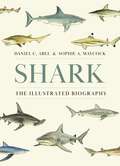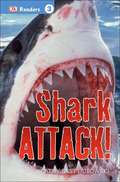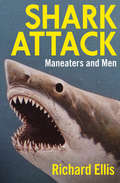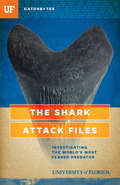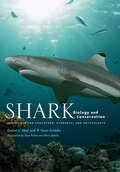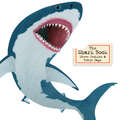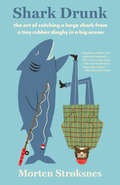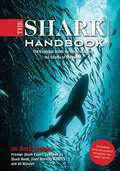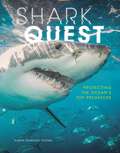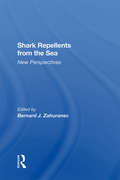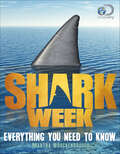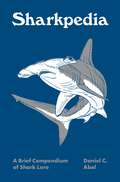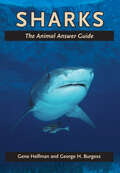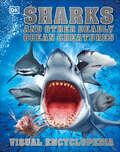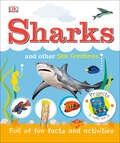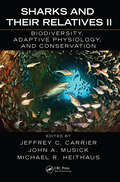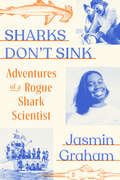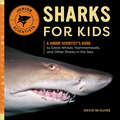- Table View
- List View
Sharing Publication-related Data And Materials: Responsibilities Of Authorship In The Life Sciences
by Committee on Responsibilities of Authorship in the Biological SciencesBiologists communicate to the research community and document their scientific accomplishments by publishing in scholarly journals. This report explores the responsibilities of authors to share data, software, and materials related to their publications. In addition to describing the principles that support community standards for sharing different kinds of data and materials, the report makes recommendations for ways to facilitate sharing in the future.
Sharing RF Spectrum with Commodity Wireless Technologies
by Jan Kruys Luke QianMuch energy has been spent on the subject of spectrum scarcity that would threaten to stunt the growth of wireless technologies and services. This concern comes on the heels of the great successes of both cellular communications and consumer oriented communications like Wi-Fi and Bluetooth that have changed the way people use computers and communications and that have led to the creation of large new markets for products and services. The response of many spectrum regulators throughout the world in addressing these concerns has been to consider releasing more spectrum for unlicensed or for shared use. An example is the spectrum that is released by the transition to digital TV: the frequencies freed up are destined, in part, to new applications that would be license exempt. A possible beneficiary of new spectrum releases would be "the smart grid", a networked application of digital sensor and control technology to the energy delivery segment of the energy utility industry. This policy has heightened the interests of all involved in spectrum sharing and many proposals are being considered or brought forward. However, theory in this area is scarce and practice proves resistive of quick solutions. A case in point is RLAN/radar spectrum sharing in the 5GHz range: six years after the ITU-R allocated this shared spectrum, the rules for sharing as well as the means to verify compliance with these rules are not fully mature. Another recent development is the interest in spectrum pricing and trading which tend to focus on the economic aspects of spectrum sharing at the expense understanding of the limitations as well as the technical possibilities of spectrum sharing.
Shark: The Illustrated Biography
by Daniel Abel Sophie A. MaycockA marvelously illustrated look at the life of the sharkNo two species of shark have the same life history, yet these magnificent creatures share many things in common. This one-of-a-kind narrative biography brings together a wide array of species from habitats around the globe, examining the biology, ecology, and behavior of sharks as well as their cultural role in human history. Written by two experienced shark educators, scientists, and conservationists, Shark: The Illustrated Biography blends engaging profiles of selected species with captivating illustrations to offer an unparalleled exploration of the life and times of the shark.Features a beautiful and informative array of watercolorsTells the biographical story of the shark using the life histories of representative species, from birth and early family life to adolescence and the adult yearsDiscusses sharks of all kinds, such as Shortfin Makos, Sandbar Sharks, Spiny Dogfish, Great Whites, Tiger Sharks, Basking Sharks, Angel Sharks, and Great HammerheadsCovers evolutionary history, distinguishing features, habitats, reproduction, and migrationExamines the role of sharks in art, music, literature, spirituality, and mythologyAn essential, must-have reference for shark lovers everywhere
Shark!
by Jerrill ParhamNIMAC-sourced textbook. Advisory: Bookshare has learned that this book offers only partial accessibility. We have kept it in the collection because it is useful for some of our members. To explore further access options with us, please contact us through the Book Quality link on the right sidebar. Benetech is actively working on projects to improve accessibility issues such as these.
Shark Attack!
by Cathy East DubowskiSavage killers or angered victims? Shark Attack tells readers the truth about the most feared creatures in the sea while exploring the anatomy of the shark and touching on different breeds including tiger sharks, bull sharks and the most feared in the sea -- the great white.
Shark Attack!
by Cathy East Dubowski"Shark Attack!" is an exciting and educational exploration of the world of sharks. This book provides fascinating facts about various shark species, their habitats, behaviors, and their role in the ocean ecosystem. It delves into their hunting techniques, unique adaptations, and the myths surrounding these incredible predators. Designed for young readers, the book combines stunning visuals with engaging narratives to make learning fun and interactive. It also emphasizes the importance of shark conservation and debunks common misconceptions. Perfect for budding marine biologists, it offers a deeper appreciation for these misunderstood creatures and their critical role in maintaining oceanic balance.
Shark Attack
by Richard EllisRenowned marine conservationist and artist Richard Ellis addresses the popular myths, misconceptions, and exploits of great white sharks, tiger sharks, bull sharks, and the many other species that roam the waters of our planetDo sharks deserve their universally bad reputation? Sharks are clearly not harmless--Shark Attack includes many true stories of seemingly unwarranted attacks on humans. Yet if sharks truly were vengeful carnivores, no beach on earth would be safe for fishing, surfing, or swimming. Ellis argues that Jaws, the popular 1975 film that misrepresented sharks in almost every detail, has damaged our perception of sharks. Today, museums and aquariums endeavor to rehabilitate the shark's image, and environmentalists and animal rights activists struggle to slow relentless overfishing. Yet their efforts may be too late to save hundreds of shark species from near or total extinction.
The Shark Attack Files: Investigating the World's Most Feared Predator
by Jeff Klinkenberg University of FloridaThe University of Florida has an ambitious goal: to harness the power of its faculty, staff, students, and alumni to solve some of society’s most pressing problems and to become a resource for the state of Florida, the nation, and the world. In 1958, a panel funded by the Office of Naval Research initiated the formation of the International Shark Attack File, the first comprehensive documentation of shark attacks on a global and historical level. In 1988, the file was transferred to the Florida Museum of Natural History at the University of Florida. It is part of the Florida Program for Shark Research, directed by George H. Burgess, the planet’s expert on shark attacks, and staffed by a world-renowned team of research scientists and educators. Travel the globe with Burgess, the Sherlock Holmes of shark attacks, as he studies mauled remains and the scars of the lucky survivors. His most famous case took him to an idyllic Red Sea resort where panic had set in after five attacks occurred in a single week. The attacks were carried out by Oceanic White Tips and a Mako, deep-water species that had no business being so close to the beach. Following the clues--dive-boat operators feeding sharks by hand to entertain tourists, the disappearance of the yearly tuna catch, and the dead sheep New Zealand cargo companies had been tossing overboard--Burgess solves the mystery of the shark attacks for Egyptian tourism officials and offers a list of best practices. But not all cases end with an easy prescription. In St. Petersburg Beach, Florida, he visits a recent shark-attack victim, bitten just off her dock on Boca Ciega Bay. While the victim would prefer to forget the fateful day the sharp-toothed jaws of the Bull Shark latched onto her leg just below the knee, Burgess gently coaxes the story from her. It will go in the file, to educate other shark researchers and educators and help us better understand the world’s most feared predator. The stories chronicled in Gatorbytes span all colleges and units across the UF campus. They detail the far reaching impact of UF’s research, technologies, and innovations--and the UF faculty members dedicated to them. Gatorbytes describe how UF is continuing to build on its strengths and extend the reach of its efforts so that it can help even more people in even more places.
Shark Attacks: Inside the Mind of the Ocean's Most Terrifying Predator
by Gordon GriceSharks are the world's most fascinating predators - capable of detecting a single drop of blood in 25 million drops of ocean and sensing electricity emitted by their prey. This ebook short takes readers deep into the realm of the very latest shark science, including new insights into the nature of shark attacks around the world.
Shark Biology and Conservation: Essentials for Educators, Students, and Enthusiasts
by Daniel C. Abel R. Dean GrubbsFeed your fascination with sharks! This complete resource enlightens readers on the biology, ecology, and behavior of sharks with approachable explanations and more than 250 stunning color illustrations.Studies of shark biology have flourished over the last several decades. An explosion of new research methods is leading to a fascinating era of oceanic discovery. Shark Biology and Conservation is an up-to-date, comprehensive overview of the diversity, evolution, ecology, behavior, physiology, anatomy, and conservation of sharks. Written in a style that is detailed but not intimidating by world-renowned shark specialists Dan Abel and Dean Grubbs, it relays numerous stories and insights from their exciting experiences in the field. While explaining scientific concepts in terms that non-specialists and students can understand, Abel and Grubbs reveal secrets that will illuminate even the experts. The text provides readers with a robust and wide range of essential knowledge as it• introduces emerging as well as traditional techniques for classifying sharks, understanding their behavior, and unraveling the mysteries of their evolution;• draws on both established shark science and the latest breakthroughs in the field, from molecular approaches to tracking technologies;• highlights the often-neglected yet fascinating subject of shark physiology, including heart function, sensory biology, digestion, metabolic performance, and reproduction;• addresses big picture ecological questions like "Which habitats do sharks prefer?" and "Where do sharks migrate and for what purpose?";• describes the astonishing diversity of sharks' adaptations to their environment;• discusses which shark conservation techniques do and don't work; and• comments on the use and misuse of science in the study of sharks.Enhanced by hundreds of original color photographs and beautifully detailed line drawings, Shark Biology and Conservation will appeal to anyone who is spellbound by this wondrous, ecologically important, and threatened group, including marine biologists, wildlife educators, students, and shark enthusiasts.
The Shark Book
by Steve Jenkins Robin PageCaldecott Honor–winning team Steve Jenkins and Robin Page explore the astonishing lives of sharks in this brilliantly illustrated picture book. Perfect for Shark Week and all year round, this ode to the notorious ocean predator with more than four hundred species will blow you out of the water!Sharp teeth, super senses, and those infamous fins—what's not to love about sharks? Caldecott Honor–winning team Steve Jenkins and Robin Page explore one of the world's most notorious—and fearsome—animals. Learn what makes a shark a shark, what sharks like to eat, and how these predators of the deep have evolved. Ever wonder which shark is the smallest? Or the fastest? Even the most deadly? You'll find your answers in The Shark Book, with countless others. In this magnificently illustrated picture book, celebrate one of the worlds oldest species that has continued to capture our imaginations and astonish us for thousands of years.
Shark Drunk: The Art of Catching a Large Shark from a Tiny Rubber Dinghy in a Big Ocean
by Morten StroksnesA salty story of friendship, adventure, and the explosive life that teems beneath the ocean, for readers of Bill Bryson and such classics as The Snow Leopard. In the great depths surrounding the Lofoten islands in Norway lives the infamous Greenland shark. At twenty-six feet in length and weighing more than a ton, it is truly a beast to behold. But the shark is not just known for its size alone: its meat contains a toxin that, when consumed, has been known to make people drunk and hallucinatory. <P><P>Shark Drunk is the true story of two friends, the author and the eccentric artist Hugo Aasjord, as they embark on a wild pursuit of the famed creature--from a tiny rubber boat. Together, the two men tackle existential questions, survive the world's most powerful maelstrom, and, yes, get drunk, as they attempt to understand the ocean from every possible angle, drawing on poetry, science, history, ecology, mythology, and their own, sometimes intoxicated, observations. <P><P>Winner of the Norwegian Brage Prize 2015 <P><P>Winner of the Norwegian Critics’ Prize for Literature 2015 <P><P>Winner of the Norwegian Reine Ord Prize at Lofoten International Literature Festival 2016
The Shark Handbook: The Essential Guide for Understanding the Sharks of the World (Shark Week Author, Ocean Biology Books, Great White Shark, Aquatic History, Science and Nature Books, Gifts for Shark Fans)
by Greg SkomalDive deep into the world of sharks, the most fascinating and misunderstood marine animals on the planet, in this stunning new edition of The Shark Handbook, written by Shark Week expert, Dr. Greg Skomal.Did you know that a whale shark&’s spots are as unique as a fingerprint? Or that sharks can go into a trance when flipped upside down? Or that the Megallodon&’s mouth was 6 feet across? With The Shark Handbook, jump into brand new facts about these fierce sea creatures! Explore all of the orders of sharks, such as:Ground sharksGreat white sharksMackerel sharksCarpet sharksand more!Learn about over 400 profiles of every shark in existence, from the first sharks living about 445 million years ago to the ones lurking in the ocean deep today. Starring spectacular, full-color photography that makes these jaw-dropping sharks come to life, this is the perfect gift for the shark enthusiast in your life.Dr. Greg Skomal, PhD is an experienced aquarist and Marine Fisheries Biologist at Martha's Vineyard Fisheries, Division of Marine Fisheries, Massachusetts. He's been keeping saltwater aquariums since childhood and has shared his extensive knowledge with viewers of National Geographic, the Discovery Channel, NBC's Today, and other media.
Shark Lady: True Adventures of Eugenie Clark
by Ann Mcgovern Ruth ChewA biography of the ichthyologist whose interest in fish began at the age of nine during weekly trips to the Aquarium in New York City. Copyright © Libri GmbH. All rights reserved.
Shark Quest: Protecting the Ocean's Top Predators
by Karen Romano YoungSharks are in trouble. Fifty shark species are at high risk of extinction, and another sixty-three are threatened. These intelligent, mysterious—and sometimes scary—fish evolved about 420 million years ago. They have adapted to survive deep in the ocean and in shallow-water habitats. Commercial fishing and finning are threatening shark populations. So is water pollution. Marine biologists and others, including young people, are working together to save these fascinating predators. Discover the work of scientists and conservationists as they study shark biology and morphology; research migration, feeding, and mating patterns; delve into human, climate, and other threats to shark habitat; and develop sophisticated technologies to aid sharks and shark research. See how scientists also educate the public about real and imagined fear of sharks and encourage citizen participation in shark conservation efforts. Learn about high-tech tagging for tracking shark migration paths. Discover the autonomous underwater vehicles and drones that divers use to observe and photograph sharks up close. Visit shark sanctuaries in the South Pacific Ocean. You'll even meet the Shark Lady, a.k.a. Eugenie Clark, a pioneer ichthyologist (shark scientist). Through research and advocacy, people around the world are working to protect—and admire—sharks. "[A]n engaging, well-researched book about a much maligned species of fish that deserves our protection."—Booklist "A remarkably thorough tour of the world of sharks and marine scientists' efforts to educate the public about our ocean's apex predators."—Kirkus Reviews
Shark Repellents From The Sea: New Perspectives
by Bernard J ZahuranecSome species of sharks, because they are large, agile predators, are extremely dangerous to humans in water. During World War II, the long-time goal of an effective shark repellent was partially realized by the U.S. Navy's development of "Shark Chaser," a copper acetate-negrosine dye mixture. But neither Shark Chaser nor other noxious or even extre
Shark Research: Emerging Technologies and Applications for the Field and Laboratory (CRC Marine Biology Series)
by Jeffrey C. Carrier, Michael R. Heithaus and Colin A. SimpfendorferOver the last decade, the study of shark biology has benefited from the development, refinement, and rapid expansion of novel techniques and advances in technology. These have given new insight into the fields of shark genetics, feeding, foraging, bioenergetics, imaging, age and growth, movement, migration, habitat preference, and habitat use. This pioneering book, written by experts in shark biology, examines technologies such as autonomous vehicle tracking, underwater video approaches, molecular genetics techniques, and accelerometry, among many others. Each detailed chapter offers new insights and promises for future studies of elasmobranch biology, provides an overview of appropriate uses of each technique, and can be readily extended to other aquatic fish and marine mammals and reptiles. Including chapter authors who were pioneers in developing some of the technologies discussed in the book, this book serves as the first single-source reference with in-depth coverage of techniques appropriate for the laboratory and field study of sharks, skates, and rays. It concludes with a unique section on Citizen Science and its application to studies of shark biology. This is a must-read for any marine biologist or scientist working in the field of shark biology, as well as marine biology students and graduates.
Shark Week: Everything You Need to Know
by Martha BrockenbroughGliding through the water at breakneck speeds--a fin, just skimming the surface of the water. The biggest jaws you've ever seen. These are the iconic images that flash through all our minds when we think of sharks, but there's so much more to know about these majestic predators of the sea.If you're already a fan of the Discovery's phenomenon Shark Week, then you will love this book! From the unique look of the prehistoric Whorl shark, to the hunting techniques of the Great White, all the thrills and chills of Shark Week are now here for year-round reading. Filled with photos, first-hand accounts of shark attacks, and unbelievable facts (Did you know that there are sharks that live in volcanoes?), this book is for every shark fanatic who wants to get even more up close and personal.Now you really can live every week like it's shark week.
Sharkpedia: A Brief Compendium of Shark Lore (Pedia Bks. #13)
by Daniel AbelA fun, pocket-size A–Z treasury about sharks, featuring fascinating, little-known facts and captivating illustrationsSharkpedia is an entertaining and enlightening celebration of sharks featuring close to 100 entries, based on the latest knowledge and enriched by original illustrations. Avoiding tired factoids, shark authority Daniel Abel gives new bite to essential information about sharks, including their adaptations as top predators, 450-million-year evolution, behavioral complexity, ecological importance, existential threats, and often sensationalized appearances in popular culture, from Jaws to Shark Week.The notion that sharks are insatiable killing machines is a toothless myth—yet the fear of shark attacks still holds on to many people like a set of locked jaws. Sharkpedia reveals that sharks are much less to be feared—and much more interesting, complicated, and important—than many realize. Filled with compelling stories, Sharkpedia debunks shark myths (for example, that sharks are large and coastal when in fact most are small and inhabit the deep sea), describes their lives (where and how long they live, how many offspring they have, what they eat, and how their bodies function), introduces a variety of iconic and obscure species (such as the Happy Eddie Shyshark), explores our love/hate relationship with sharks, and much more.With charming drawings by leading shark artist Marc Dando, Sharkpedia is a scientific and cultural treasure trove that will leave you with new insights about these remarkable animals. Dive in!Features a cloth cover with an elaborate foil-stamped design
Sharks: The Animal Answer Guide (The Animal Answer Guides: Q&A for the Curious Naturalist)
by Gene Helfman George H. BurgessDo sharks lay eggs or give birth to live young? Do sharks sleep? How long do they live? How likely are shark attacks? This book answers your questions about some of nature’s most misunderstood animals.Answering every conceivable question about sharks, authors Gene Helfman and George H. Burgess describe the fascinating biology, behavior, diversity (there are more than 1,000 species worldwide), and cultural importance of sharks, their close relationship to skates and rays, and their critical role in healthy ecosystems.Helfman and Burgess take readers on a round-the-world tour of shark habitats, which include oceans as well as lakes and even rivers (as far up the Mississippi as St. Louis). They describe huge, ferocious predators like (Great) White and Tiger sharks and species such as Basking and Whale sharks that feed on microscopic prey yet can grow to lengths of more than 40 feet. The mysterious and powerful Greenland shark, the authors explain, reaches a weight of 2,200 pounds on a diet of seal flesh. Small (less than 2-foot long) Cookiecutter sharks attack other sharks and even take a chunk out of the occasional swimmer.Despite our natural fascination with sharks, we have become their worst enemy. Many shark species are in serious decline and a number are threatened with extinction as a result of overfishing and persecution. Sharks: The Animal Answer Guide presents a perfect mix of current science, history, anthropology, intriguing facts, and gripping photographs. Whether your fascination with sharks stems from fear or curiosity, your knowledge of these animals will improve immensely when you consult this book.
Sharks and Other Deadly Ocean Creatures Visual Encyclopedia (DK Children's Visual Encyclopedias)
by DKSwimming with sharks sounds a terrifying prospect, but not when it is from the comfort of your living room. This comprehensive visual encyclopedia takes you deep into the world&’s waters to meet the deadliest ocean predators – without you even getting wet!Do you know which creature has tentacles longer than a bus? Or what was the largest shark that ever lived? Where does the tiger shark get its name? Which fish has the deadliest venom? And which fish has the strongest bite of anything on Earth? Sharks and Other Deadly Ocean Creatures answers all these questions and many, many more. More than 200 fierce fish from the past and present are featured in fact-packed profiles. You&’ll come face to face with great white sharks, manta rays, saltwater crocodiles, giant squid, biting barracudas, and predatory piranhas all shown with exciting CGI technology and stunning photography. You&’ll learn about shark anatomy, behaviour, and habitats alongside fun, factual text presented in an easily accessible format. Whether you&’re a water baby or simply studying for a school project, this is your one-stop shop for sharks and other deadly ocean creatures.
Sharks and Other Sea Creatures (Projects to Make and Do)
by DKPacked with fun activities, crafts, reading games, and amazing facts, kids can take a dive under the waves and meet all the colorful creatures beneath—from clown fish to starfish to jellyfish—in this educational project book.In Sharks and Other Sea Creatures, each page has engaging photographs with clear text and simple step-by-step instructions for young readers to follow as they complete each project. Kids can learn how to create an egg carton ocean, make pretty paper plate clown fish, and make their way through an octopus maze. Perfect for kids who love the enchanting creatures of the deep, this book will improve their dexterity, memory, and brain development with each activity.Keep kids entertained as they learn with Sharks and Other Sea Creatures.Series Overview: Created especially for kids ages 3–5, DK's Practical Facts series blends gentle educational content with simple practical activities such as crafts, cooking, and counting, providing young readers with a broad reading experience in which they learn by doing. The simple activities reinforce the fun facts and aid in the development of literacy, numeracy, memory, and dexterity. Keep kids entertained as they learn with DK's Practical Facts series.
Sharks and Their Relatives II: Biodiversity, Adaptive Physiology, and Conservation (CRC Marine Biology Series)
by Jeffrey C. Carrier John A. Musick Michael R. HeithausSince the award-winning first volume, The Biology of Sharks and Their Relatives, published in 2004, the field has witnessed tremendous developments in research, rapid advances in technology, and the emergence of new investigators beginning to explore issues of biodiversity, distribution, physiology, and ecology in ways that eluded more traditional
Sharks Don't Sink: Adventures of a Rogue Shark Scientist
by Jasmin GrahamThe uplifting story of a young Black scientist&’s challenging journey to flourish outside the traditional confines of academia, inspired by her innate connection to nature&’s most misunderstood animal—the shark."Jasmin Graham has that winning combination of talent and grit needed to excel as a scientist. Every girl who wants to be a marine biologist should have this book." —Hope Jahren, New York Times bestselling author of Lab Girl and The Story of MoreSharks have been on this planet for over 400 million years, so there is a lot they can teach us about survival and adaptability. For example: how do sharks, which unlike other fish are denser than water, stay afloat? They keep moving. When Jasmin Graham, an award-winning young shark scientist, started to feel that the traditional path to becoming a marine biologist was pulling her under, she remembered this important lesson: keep moving forward.If navigating the choppy waters of traditional academic study was no longer worth it, then that meant creating an ocean of her own. Jasmin joined with three other Black women to form Minorities in Shark Sciences (MISS), an organization dedicated to providing support and opportunities for other young women of color. She became an independent researcher: a rogue shark scientist, seeking ways to keep these extraordinary endangered creatures swimming free—just like her.Sharks Don&’t Sink is a riveting, moving, and ultimately triumphant memoir at the intersection of science and social justice: a guidebook to how we can all learn to respect and protect some of nature&’s most misunderstood and vulnerable creatures—and grant the same grace to ourselves.
Sharks for Kids: A Junior Scientist's Guide to Great Whites, Hammerheads, and Other Sharks in the Sea (Junior Scientists)
by David McGuireMeet the ocean's apex predators with the Junior Scientists series for kids ages 6 to 9 Sharks come in all shapes and sizes, from giant whale sharks the size of school buses to tiny dwarf lanternsharks only eight inches long. Sharks for Kids introduces you to these magnificent creatures through vivid illustrations and photographs of some of the biggest, smallest, and strangest sharks swimming the seas. In this top choice among sharks books for kids, you'll get to know goblin sharks, thresher sharks, and many more. In one of the most engaging sharks books for kids, you'll discover tons of in-depth facts about some of your favorite sharks, including what they eat, how they hunt, their life cycles, and how people around the world are working to protect them. You'll also learn about how they see, smell, and communicate in the deep sea. Your underwater shark adventure begins here! This standout selection among sharks books for kids includes: So many sharks!—Check out all the wild information on a variety of species. Age-appropriate—The content inside this outstanding pick among sharks books for kids is the perfect reading level for kids ages 6 to 9. Unbelievable images—Sharks books for kids should have colorful photos and illustrations, and this book delivers. If you've been searching for in-depth sharks books for kids, Sharks for Kids is a cut above the rest.


